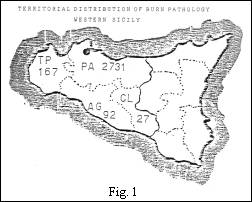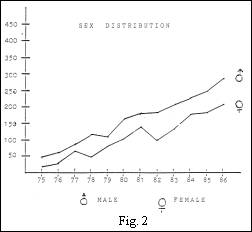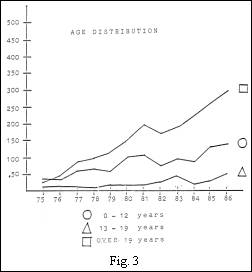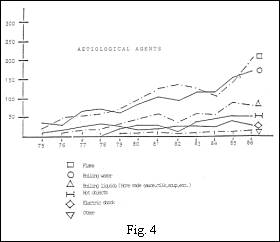Annals
of the M.B.C. - vol. 1° - n° 1 - September 1987
EPIDEMIOLOGICAL INVESTIGATION OF BURNS TO THE HAND BETWEEN 1975 AND 1986
AT THE DIVISION OF RECONSTRUCTIVE PLASTIC SURGERY AND BURN THERAPY, PALERMO
Conte F., Fallea A.M., Rairnondi A.,
Sucarneli M., Parisi L., Masellis M.
SUMMARY. The
authors have carried out a study of burns to the hand treated-over a ten-year period in
order to evaluate the rate and the extent of bum damage in relation to sex, age,
aetiological agents, the initial type of clinical evaluation, first treatment and its
earliness. They draw some useful conclusions for the pr,-paration of a campaign of
prevention in the local territory, stressing the need for more precise information
regarding the concept of the gravity of the acute bum, wider knowledge of the activities
of Specialized Centres, a re-thinking of certain parameters of accident medicine in the
territory, and the usefulness of an informative campaign in schools and work-places.
Introduction
A study was carried out of burns to
the hand treated over a ten-year period at the Division of Plastic Surgery and Burn
Therapy in Palermo, which covers four provinces of western Sicily having an overall
population of over 3 million inhabitants.
Altogether 3077 cases were treated, distributed as follows: province of Caltanissetta 27,
province of Agrigento 92, province of Trapani 167, province of Palermo 2791.
The aim of the study was to assess the rate and the extent of bum damage in the hand in
relation to sex, age, aetiological agents, initial type of clinical assessment (whether
specialist or not), first treatment and its earliness, with a view to deciding some useful
guidelines for the preparation of an effective prevention campaign in the local territory.
Analysis and assessment of results
The male sex is more efrected with a
rate of 1861 cases (60.48%) against 1216 (39.52%) females. As to age three ranges were
considered: up to 12 years, with 988 cases (32.10%), 13 to 18 years with 263 cases
(8.54%), and from 19 years upwards with 1825 cases (59.31%).
Flame, with a rate of 115 5 cases (3 7.5 3 %) was the most frequent aetiological agent
involved, followed by boiling water in 825 cases (26.81%), other boiling liquids (soup,
pap, coffee, tea, mill.) in 461 cases (14.98%), hot objects in 282 cases (9.16%),
electrical .burns in 26 5 cases (8.6 1 %), chemical burns and others in 89 cases (2.89%).
More than half of the cases, to be precise 58.98%, were examined and received their first
and subsequent treatment in our Division, achieving complete functional recovery in nearly
all cases.
One first consideration that can be made is that the number of patients coming to our
Centre is inversely proportional to the distance of the various provinces. It is very
probable that in lhe more distant provinces, where the activity of the,Centre is perhaps
little known, the gravity of han~ burns is underestimated in the acute phase; this is
i-onfirmed by the high number of cases of secondary pahology cominj to our Centre in the
form of burns Yi a stage of advanced granulation and/or serious
infection, and of burns that have healed but left incapacitating scarring.
The higher rate of burns among males is due, in the case of adults, to the kind of work
engaged in and, in the case of children, to the greater liveliness and imagination shown
by boys in their games.
The high number of burns in children underlines the statistical importance of accidents in
the home, usually a result of carelessness or lack of proper vigilance.
Regarding aetiological agents, our data do not seem different from those found by other
authors: flame is the thermic agent most frequently encountered in an outdoor work
environment, while boiling liquids are the commonest cause of burns in the home
environment.
The low rate of cases of secondary pathology among patients treated in our Centre confirms
that it is of fundamental importance in this kind of accident to make an immediate and
accurate clinical assessment and to give early and appropriate treatment, even in the
early stages of initial therapy.
Conclusions
In order to prepare a valid and eftective campaign against accidents causing hand
burns, we may draw the following conclusions on the basis of the findings of this
investigation:
- it is essential that there should be
more precise information regarding the concept of the gravity of the acute burn
General practitioners and sometimes even physicians in peripheral hospitals tend to
evaluate the gravity of a burn more on the basis of its extent (% 13SA) than on its
localization in particular sites such as the hands, face, genitals etc. In the case of
hand burns, although risk to life is limited, there is a high risk of forms of secondary
pathology leading to severe incapacitation, all the more frequently if treatment has not
been early and appropriate.
- it is necessary to provide exhaustive
information about the activity of Specialized Centres in the area. These Centres are in a
position to guarantee the best possible treatment and are provided with specific equipment
and protocols (amniotic membrane, medicated gauze, siliconated dressings, aimed antibiotic
therapy, appropriate detension incisions, chemical and surgical escharectomy, early
post-operative physiokinesitherapy, elastic supports, dynamic splints); they must also
provide therapeutic suggestions for severe patients awaiting transfer. The advantage of
early admission means reductions in: the duration of the illness, hospitalization time,
period off work, medical expenses and insurance payments.
- as the analysis shows a high number of
accidents both at home and at work, it is necessary to reconsider some parameters
regarding the incidence of such accidents, and in particular the ways in which they can be
foreseen and avoided.
Two fundamental aspects must be considered, one technical and the other human.
Greater attention must be paid to the number and to the quality of periodic tests and
trials of the safety requisites of electrical equipment, gas equipment, electric domestic
appliances and various other domestic utensils.
There must be an intensification of medical examinations for potential workers in ordei to
direct them towards the kind of work they are physically and mentally best suited for, and
there must be stricter medical control in business and industry of the efficiency of the
working environment.
- an informative campaign in schools and
in workplaces, with talks, videotapes, cartoons, hand-outs of brochures and leaflets etc,
could help to make persons of all ages more aware of the need of safety and provide them
with an anti-accident outlook, based on a more cautious, more reflective and more sensible
behaviour.
RÉSUMÉ. Les auteurs ont fait
une enquête sur les brûlures des mains, traitées pendant dix ans, pour évaluer le taux
et la gravité de l'atteinte thermique par rapport au sexe, l'âge, aux agents
étiologiques, au type initial d'évaluation clinique, au premier traitement et son
opportunité. Ils ont tiré des indications utiles pour la préparation d'un programme de
prévention dans le territoire en mettant en évidence la nécessité d'une information
plus exacte sur le concept de gravité de la brûlure en phase aiguë, d'une majeure
information sur l'activitè des Centres Spécialisés, du besoin d'une révision de
quelques paramètres de la médecine des accidents, et de l'utilité d'une campagne
d'informations dans le monde de l'école et du travail.
|



